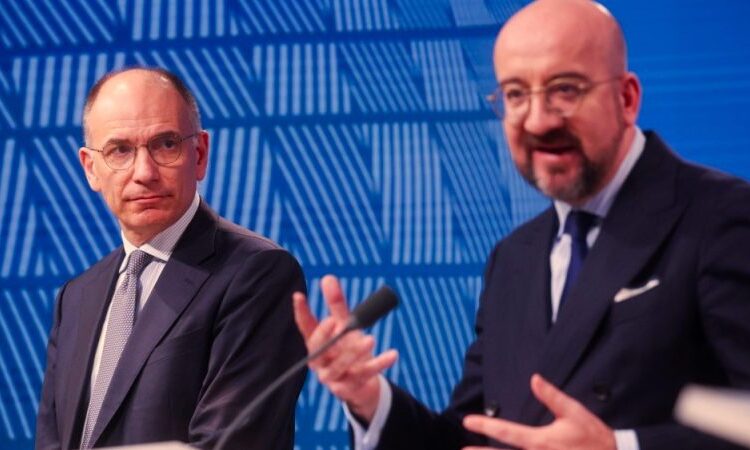Capital Markets Union best route to rival US IRA, Michel says as Letta outlines sweeping financial sector plan – Euractiv

European Council president Charles Michel said on Wednesday (17 April) that Europe’s answer to the US’s multibillion green subsidy programme should be to deepen its single market for financial capital.
Speaking at a press conference in Brussels alongside former Italian prime minister Enrico Letta — who is due to present his much-anticipated single market report to EU leaders on Thursday morning — Michel said that further integration of the Capital Markets Union (CMU) would unlock “trillions of euros” in potential investments, thereby rivalling if not surpassing the $369 billion US Inflation Reduction Act (IRA).
“I am absolutely convinced for my part that the Capital Markets Union is the best European IRA that we can develop since it is trillions of euros of resources that can be mobilised — which are not [mobilised] today — to stimulate, support, to develop innovation, to invest,” said Michel in response to a question from Euractiv.
Michel emphasised that consolidating Europe’s energy and telecoms markets and reducing companies’ administrative burden will similarly prove “key” to arresting Europe’s industrial decline, both points echoing recommendations put forward by Letta’s report.
However, the Council president put much greater emphasis on placing a greater “trust” in the private sector.
“In a nutshell, I fear what we lose when we don’t trust the businesses,” Michel said. “I think that we should base our approach in terms of regulation on the principles of trust and confidence and not the opposite.”
“Sometimes I have the impression that the starting point is the principle of distrust, a lack of confidence, and this has an effect,” he added.
In contrast to Michel, Letta highlighted the need for more EU-wide public funding and a “European industrial policy” to address the bloc’s industrial malaise.
“European industrial policy is not the sum of 27 national industrial policies,” said Letta in response to another question from Euractiv.
“The link with finance, energy and telecoms is very strong on the point of a European industrial policy,” said Letta.
Private market flows ‘a key game changer’: Letta’s detailed roadmap
“And on the comparison with IRA, I say that the link with the savings and financial market level is, for me, one of the key game changers that we can put on the table,” he added.
On financial markets integration, Letta’s report provides several detailed proposals on how to shore up competitiveness and investment flows.
These include introducing an “EU-wide scheme” to incentivise European citizens to invest more — as the bloc “is home to a staggering €33 trillion euros in private savings, currently sitting mainly in current accounts,” he argued.
In the areas of private debt, private equity and assets from SMEs and non-listed companies, this would be helped, Letta said, by combining the existing ELTIF legislation — which allows non-professional investors to allocate to alternative investment funds — with coordinated national tax incentives.
To broaden participation in capital markets, the former Italian prime minister proposes “a three-level [European] framework” that recognises, alongside institutional and retail investors, a new class of “qualified investors.”
Another route of increasing inflows would be through streamlining frameworks for approving insurers’ so-called “internal models” — which calculate how much capital they set aside to hedge their investment exposures. This, he says, could be done by establishing a dedicated team that connects national authorities with the EU’s insurance watchdog.
Similarly, bank capital requirements could be revised and made “easier,” he said.
Europe’s securitisation market could also be mobilised to channel more investments into real-economy and green-economy assets, by “reforming” the related regulatory framework and setting out green securitisation products.
To further enhance the framework for green transition investment, Letta also recommends an EU-level scheme of “European Green Guarantee (EGG),” which he foresees could help banks lend to the sustainable economy by “neutralis[ing] the so-called ‘green transition risk’.”
The Italian, currently serving as chair of the Jacques Delors Institute, also said EU-issued bonds should be put “firmly at the centre of the EU’s financial architecture”.
Only last month, Letta noted, “there were for the first time in the market more than €1 trillion (worth) of European supranational bonds” — issued by the European Commission, the European Investment Bank, and the European Stability Mechanism.
These triple-A assets, “fully backed […] by European sovereigns,” are traded separately despite their close comparability — “which hurts their pricing given the relative lack of liquidity coming from the still limited and fragmented issuance.” These bonds, he said, should be streamlined through a “single issuance for all EU institutions” approach.
Letta is also calling for a consolidation of the clearing and settlement markets, setting up a unified infrastructure along the lines of the US mutually-owned and “utility-like Depository Trust and Clearing Corporation (DTCC).”
“Judging by the US experience, where stock exchange competition is strong, it seems that there is no apparent need for competition in the clearing and settlement markets, as long as there is fair and open access for all actors, proper governance and sufficient incentives for innovation.”
[Additional reporting by Anna Brunetti]
[Editing by Anna Brunetti/Rajnish Singh]






